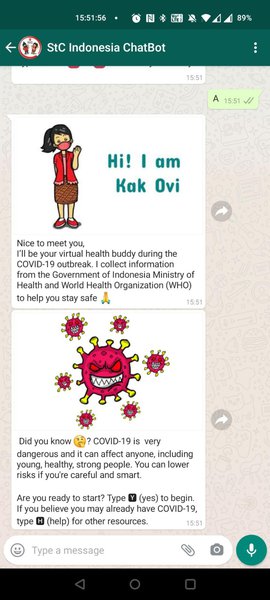How Save the Children built their own communication platform to serve children during the pandemic and beyond
Time to read: 5 minutes

When COVID-19 hit, like nearly every retail store, school, and business, our international humanitarian aid organization had to adapt traditional in-person programs to digital-assisted offerings. I head up technology and data for development in Asia and East and Southern Africa for Save the Children, an international non-governmental organization (NGO) protecting children. I’m responsible for integrating technology best practices to serve children better. Drawing on years of experience building technology platforms and connectivity for nonprofits in emerging markets, we took a test-iterate-and-learn approach to digitally transforming one of the largest humanitarian organizations in the world.
Rather than building one-off solutions to support different programs, we built a communications platform that teams across many countries could tweak and deploy to meet their unique needs. Below we share our approach that other NGOs, and even global corporations, can learn from when building digital communications for a varied set of programs, products, and services.
About Save the Children
Save the Children was founded in 1919 by a bold and forward thinking woman who wanted to change the world, and that has been how we have done business ever since.
For more than 100 years, we’ve worked to find new and better ways to give children a healthy start in life, the opportunity to learn, and protection from harm. We’re on the ground in over 100 countries helping the most at-risk and hardest-to-reach children through pioneering health, education and protection programs, partnering with local communities to create lasting, life-changing results. Our work takes place in diverse settings–from the U.S. and U.K., to Somali and Kenya, to Bangladesh and the Philippines.
Innovation has been at the core of Save the Children’s identity since our founding, and we plan to continue innovating to support the potential of children, adolescents–and women– around the world.
We see many additional opportunities to use digital technologies to amplify, extend and measure our impact. Although we’ve applied technology to many of our initiatives over the years, harnessing the power of digital tools and solutions will be a key and ever-growing component of our work going forward.
Supporting hundreds of unique programs
At Save the Children, our programs are our products. Unlike most commercial companies, international nonprofits and non-governmental organizations (NGOs) typically don’t sell set products or services, but rather initiate individual programs tailored to the needs of the specific group of people we support and to their local context–be it an Ebola outbreak or the ravages of climate change.
Our work ranges from training frontline healthcare workers through our health and nutrition programs to supporting expectant mothers and their newborn children. We help governments strengthen their child protection systems, fight child marriage, train social workers and respond to emergencies to protect children in conflict and natural disasters. These programs take place in vastly different settings from urban centers like Jakarta, Indonesia, to remote and sparsely populated regions like Kenya’s Turkana County.
Given the diversity of the regions in which we work and the areas of impact on which we focus, it is no simple task to conceive, validate and then roll out innovations and digital tools. We know from experience that there is no single solution that works everywhere and can be quickly deployed across the board.
As a result, we look to build flexible tools that can be adapted to match a specific project’s needs and the environment in which it operates.
Building an innovation lab focused on common tech platforms
We identified three solutions that broadly apply to many areas of our work: multi-channel communications solutions (supporting SMS, messaging, IVR and voice), learning-management systems, and data analytics.
- We use communications to connect our staff with parents, guardians, educators, and children participating in nearly all of our programs. We use SMS, WhatsApp, voice calls, and interactive voice response to help deliver education trainings, empower our community to raise children’s rights violations, and receive feedback from participants of our programs. SMS and What’sApp have been particularly effective during COVID-19, helping us connect children, parents and teachers in remote communities whether to support at-home learning or deliver critical health and hygiene messages.
- We use learning management systems to train our staff, partners,and community members on how to bring about positive change for the children we serve.
- Data analytics are a critical tool that enables us to understand the impact and reach of our programs, as well as whether our programs are effectively changing children’s outcomes.

To identify the right technologies, pilot programs and bring them to scale, we launched a technology innovation group called DigiLabs. DigiLabs brings together our internal technologists and programmatic experts to collaborate and identify where digital solutions can be most impactful. We invited outside experts from the private sector, academia, peer organizations, and social enterprises to work with us on these challenges.
Starting with a pilot
Early in building DigiLabs, we partnered with our Center for Utilizing Behavioral Insights for Children (CUBIC) in Indonesia, using a chatbot to provide accurate information on COVID-19 and reduce behaviors that put children and families at risk of contracting the disease.
We realized that using communications channels like WhatsApp or SMS is a common need for many of our programs, and chatbots are tools that can be easily accessed by many users. Clients don’t need to install a new app and SMS even works on feature phones, and so we decided to use this program to pilot some of our new technology platforms.
Our plan was to engage users over WhatsApp, which is widely accessible and used in Indonesia, to share accurate information on COVID-19. We tested users’ knowledge in weekly quizzes, and, most important, completed a risk assessment to identify any areas where risk of exposure could be reduced by adjusting their habits. This chatbot would be called “Sahabat Peduli Corona,” which roughly translates to “Your COVID Protection Buddy.”

Rather than creating a single-use solution for the Indonesia chatbot, we established and implemented a framework solution using Twilio that allows us to quickly launch additional chatbots and other interactive communications solutions without any significant upfront technology investment. Now, we have templates built out for bulk notifications, back-and-forth conversations and interactive voice response. Using these templates, our program teams can adapt the message content and contacts based on their specific work.
During the development and implementation of this framework, we collaborated closely with Twilio’s support team, which allowed us to focus on functionality without any technology integration challenges slowing us down.
Scaling for the future
What’s the power of this approach? It means that for future rollouts of similar programs, we can focus on the actual solution implementation rather than building the technology from scratch. This saves us weeks of time when spinning up communications platforms for new programs and settings. We have a number of future rollouts of other chatbots coming soon.
For example in Sri Lanka, we are using a similar chatbot to support child rights and protection, enabling family members–or children themselves–to report any violations. We’re also launching a program using the chatbots and other communications tools to combat COVID-19 vaccine misinformation in various countries where we work. We will be providing fact-based information on vaccines to counter rumors and misinformation that is fueling vaccine hesitancy.
Going forward, DigiLabs will tackle similar technology challenges that have broad applications in our work. We recognize that collaboration with and tapping into the expertise of the tech sector is key to achieving these goals. By bringing together internal experts and working across regions and programs, DigiLabs provides a uniquely effective way for partners to engage with Save the Children and contribute to addressing large-scale problems affecting girls and boys around the world.
We welcome other innovative partnerships. To learn more about or support Save the Children’s work, we invite you to visit our website, savethechildren.org.
Related Posts
Related Resources
Twilio Docs
From APIs to SDKs to sample apps
API reference documentation, SDKs, helper libraries, quickstarts, and tutorials for your language and platform.
Resource Center
The latest ebooks, industry reports, and webinars
Learn from customer engagement experts to improve your own communication.
Ahoy
Twilio's developer community hub
Best practices, code samples, and inspiration to build communications and digital engagement experiences.


